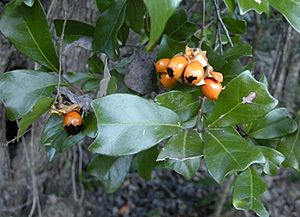Cupaniopsis wadsworthii facts for kids
Quick facts for kids Cupaniopsis wadsworthii |
|
|---|---|
 |
|
| Leaves and flowers of the tuckeroo at Mount Archer National Park Rockhampton, Queensland, Australia | |
| Scientific classification | |
| Genus: |
Cupaniopsis
|
| Species: |
wadsworthii
|
| Synonyms | |
|
|
The Cupaniopsis wadsworthii, often called duckfoot or scrub tuckeroo, is a fascinating Australian plant. It's a type of shrub that belongs to the flowering plant family called Sapindaceae. This family also includes many other trees and shrubs. You can find these plants growing naturally in rainforests and seasonally dry rainforests. They usually prefer to grow on rocky hill slopes. Their natural home stretches from Magnetic Island southwards to about Bulburin National Park in central eastern Queensland.
What Does the Duckfoot Look Like?
These plants usually grow as slender shrubs. They can reach up to three metres (about 10 feet) tall. Their main stem can be up to 50 centimetres (about 20 inches) wide.
Leaves of the Duckfoot
The leaves of the duckfoot are special. They are pinnate, which means they have leaflets arranged along a central stem, like a feather. They grow alternately along the branch. Each leaf has between four and eight smaller leaflets. These leaflets have a very unique triangular shape. They are wide at the tip and then narrow down to a point where they connect to the leaf stalk.
Many of these plants have leaflets with two points on the outer edge and one point on the inner edge of the wide tip. This pattern looks a lot like the webbing between the toes of water birds, such as ducks! This is why one of its common names is duckfoot.
Fruits and Seeds
The fruits of the duckfoot are bright and colorful. They are orange to yellow capsules, which are like small cases. Each fruit has three distinct lobes, or sections. Inside each lobe, you'll find a glossy, dark brown seed. What makes these seeds even more interesting is that each one is covered in a bright orange aril. An aril is a fleshy covering that grows around the seed.
These fruits usually ripen between October and December. When they are ripe, their bright colors and tasty arils attract many different birds. The birds help to spread the seeds, allowing new duckfoot plants to grow in other areas.


